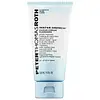What's inside
What's inside
 Key Ingredients
Key Ingredients

 Benefits
Benefits

 Concerns
Concerns

 Ingredients Side-by-side
Ingredients Side-by-side

Water
Skin ConditioningHyaluronic Acid
HumectantGlycerin
HumectantButylene Glycol
HumectantAlcohol Denat.
AntimicrobialDimethicone
EmollientGlyceryl Stearate
EmollientPEG-100 Stearate
Panthenol
Skin ConditioningSimmondsia Chinensis Seed Oil
EmollientTocopheryl Acetate
AntioxidantRetinyl Palmitate
Skin ConditioningTriticum Vulgare Germ Oil
EmollientAluminum Starch Octenylsuccinate
AbsorbentPhospholipids
Skin ConditioningPantothenic Acid
Skin ConditioningMethyldihydrojasmonate
MaskingYeast Extract
Skin ConditioningPanax Ginseng Root Extract
EmollientCamellia Sinensis Leaf Extract
AntimicrobialOrmenis Multicaulis Oil
MaskingStearic Acid
CleansingGlyceryl Dilaurate
EmollientCarbomer
Emulsion StabilisingTriethanolamine
BufferingAsiaticoside
AntioxidantAsiatic Acid
Skin ConditioningMadecassic Acid
Skin ConditioningAscorbyl Palmitate
AntioxidantDisodium EDTA
1,2-Hexanediol
Skin ConditioningCaprylyl Glycol
EmollientWater, Hyaluronic Acid, Glycerin, Butylene Glycol, Alcohol Denat., Dimethicone, Glyceryl Stearate, PEG-100 Stearate, Panthenol, Simmondsia Chinensis Seed Oil, Tocopheryl Acetate, Retinyl Palmitate, Triticum Vulgare Germ Oil, Aluminum Starch Octenylsuccinate, Phospholipids, Pantothenic Acid, Methyldihydrojasmonate, Yeast Extract, Panax Ginseng Root Extract, Camellia Sinensis Leaf Extract, Ormenis Multicaulis Oil, Stearic Acid, Glyceryl Dilaurate, Carbomer, Triethanolamine, Asiaticoside, Asiatic Acid, Madecassic Acid, Ascorbyl Palmitate, Disodium EDTA, 1,2-Hexanediol, Caprylyl Glycol
Sodium Cocoyl Isethionate
CleansingGlycerin
HumectantGlyceryl Stearate Se
EmulsifyingStearic Acid
CleansingCoconut Acid
CleansingCetearyl Alcohol
EmollientCocos Nucifera Oil
MaskingSodium Caproyl Methyltaurate
CleansingDisodium Cocoamphodiacetate
CleansingPolyglyceryl-10 Myristate
Skin ConditioningSodium Methyl Stearoyl Taurate
CleansingSodium Hyaluronate
HumectantAlthaea Officinalis Root Extract
Skin ConditioningSambucus Nigra Fruit Extract
AstringentSodium PCA
HumectantGlycol Distearate
EmollientSodium Chloride
MaskingSodium Isethionate
CleansingXanthan Gum
EmulsifyingPropylene Glycol
HumectantSodium Hydroxide
BufferingTetrasodium EDTA
Mica
Cosmetic ColorantPotassium Sorbate
PreservativeSodium Benzoate
MaskingEthylhexylglycerin
Skin ConditioningPhenoxyethanol
PreservativeSodium Cocoyl Isethionate, Glycerin, Glyceryl Stearate Se, Stearic Acid, Coconut Acid, Cetearyl Alcohol, Cocos Nucifera Oil, Sodium Caproyl Methyltaurate, Disodium Cocoamphodiacetate, Polyglyceryl-10 Myristate, Sodium Methyl Stearoyl Taurate, Sodium Hyaluronate, Althaea Officinalis Root Extract, Sambucus Nigra Fruit Extract, Sodium PCA, Glycol Distearate, Sodium Chloride, Sodium Isethionate, Xanthan Gum, Propylene Glycol, Sodium Hydroxide, Tetrasodium EDTA, Mica, Potassium Sorbate, Sodium Benzoate, Ethylhexylglycerin, Phenoxyethanol
Ingredients Explained
These ingredients are found in both products.
Ingredients higher up in an ingredient list are typically present in a larger amount.
Glycerin is already naturally found in your skin. It helps moisturize and protect your skin.
A study from 2016 found glycerin to be more effective as a humectant than AHAs and hyaluronic acid.
As a humectant, it helps the skin stay hydrated by pulling moisture to your skin. The low molecular weight of glycerin allows it to pull moisture into the deeper layers of your skin.
Hydrated skin improves your skin barrier; Your skin barrier helps protect against irritants and bacteria.
Glycerin has also been found to have antimicrobial and antiviral properties. Due to these properties, glycerin is often used in wound and burn treatments.
In cosmetics, glycerin is usually derived from plants such as soybean or palm. However, it can also be sourced from animals, such as tallow or animal fat.
This ingredient is organic, colorless, odorless, and non-toxic.
Glycerin is the name for this ingredient in American English. British English uses Glycerol/Glycerine.
Learn more about GlycerinStearic Acid is a fatty acid. It is an emollient, emulsifier, and texture enhancer.
As an emollient, stearic acid helps soften skin. It aids the skin's protective barrier by preventing water loss. It also provides a gentle cleansing effect without stripping away natural oils.
Stearic acid may also be used to enhance the texture of products. It can add volume and stabilize ingredients such as water and oil. This can help water and oil ingredients from separating.
Sources of stearic acid include animal or vegetable fats/oils such as coconut or shea. It can be naturally found in butter, cocoa butter, shea butter, vegetable fats, and animal tallow.
This ingredient may not be Malassezia folliculitis, or fungal-acne safe.
Learn more about Stearic Acid